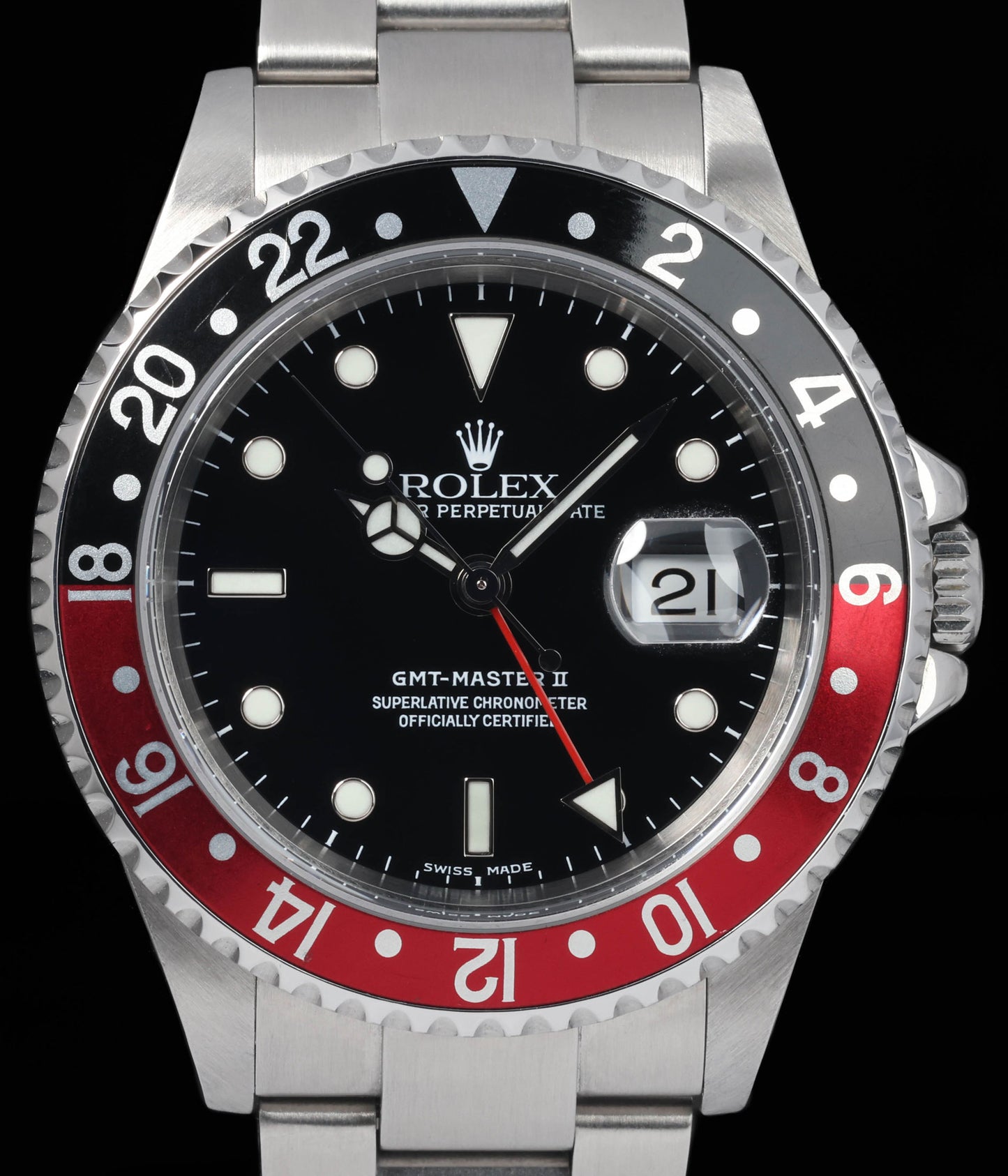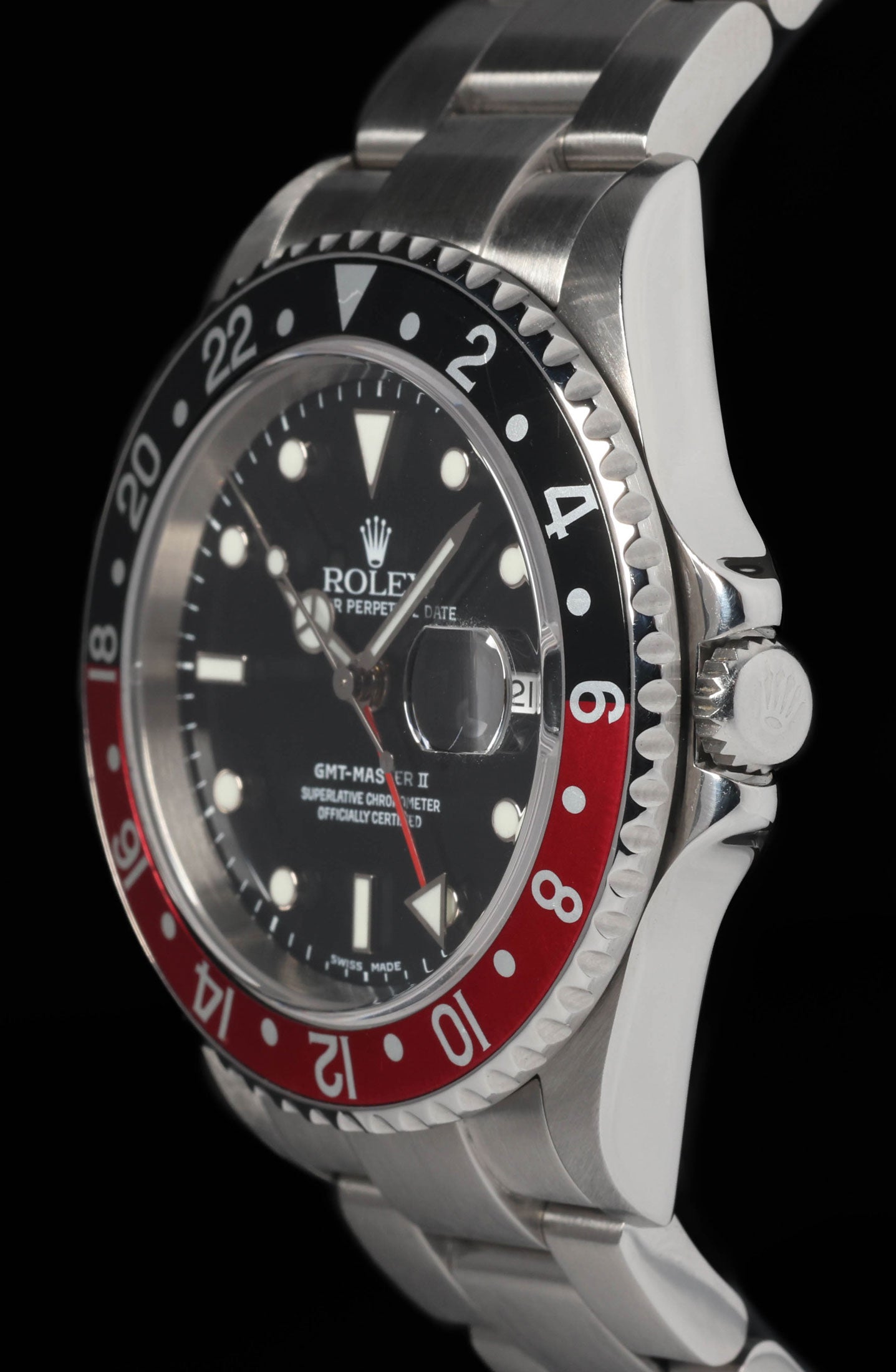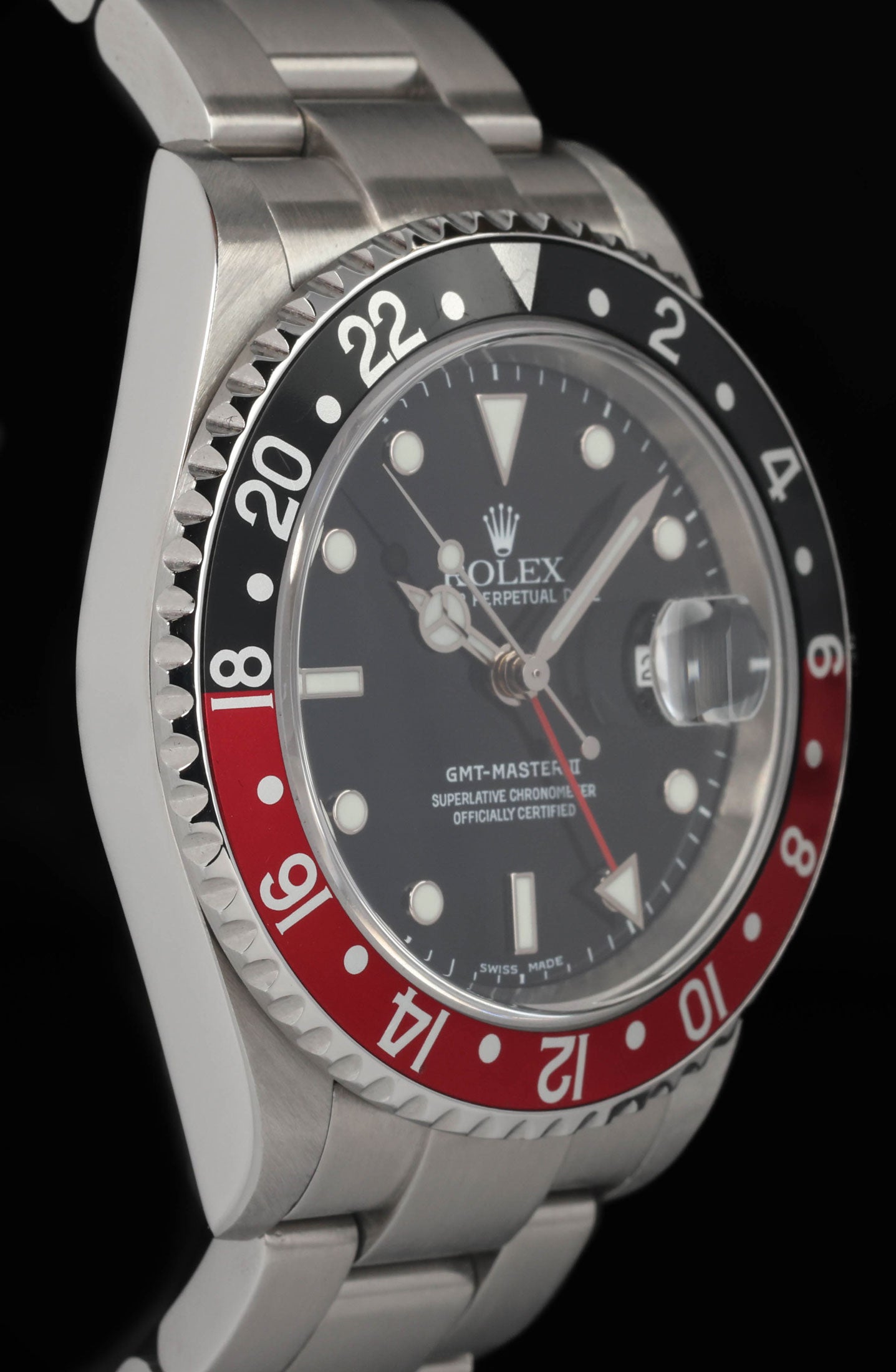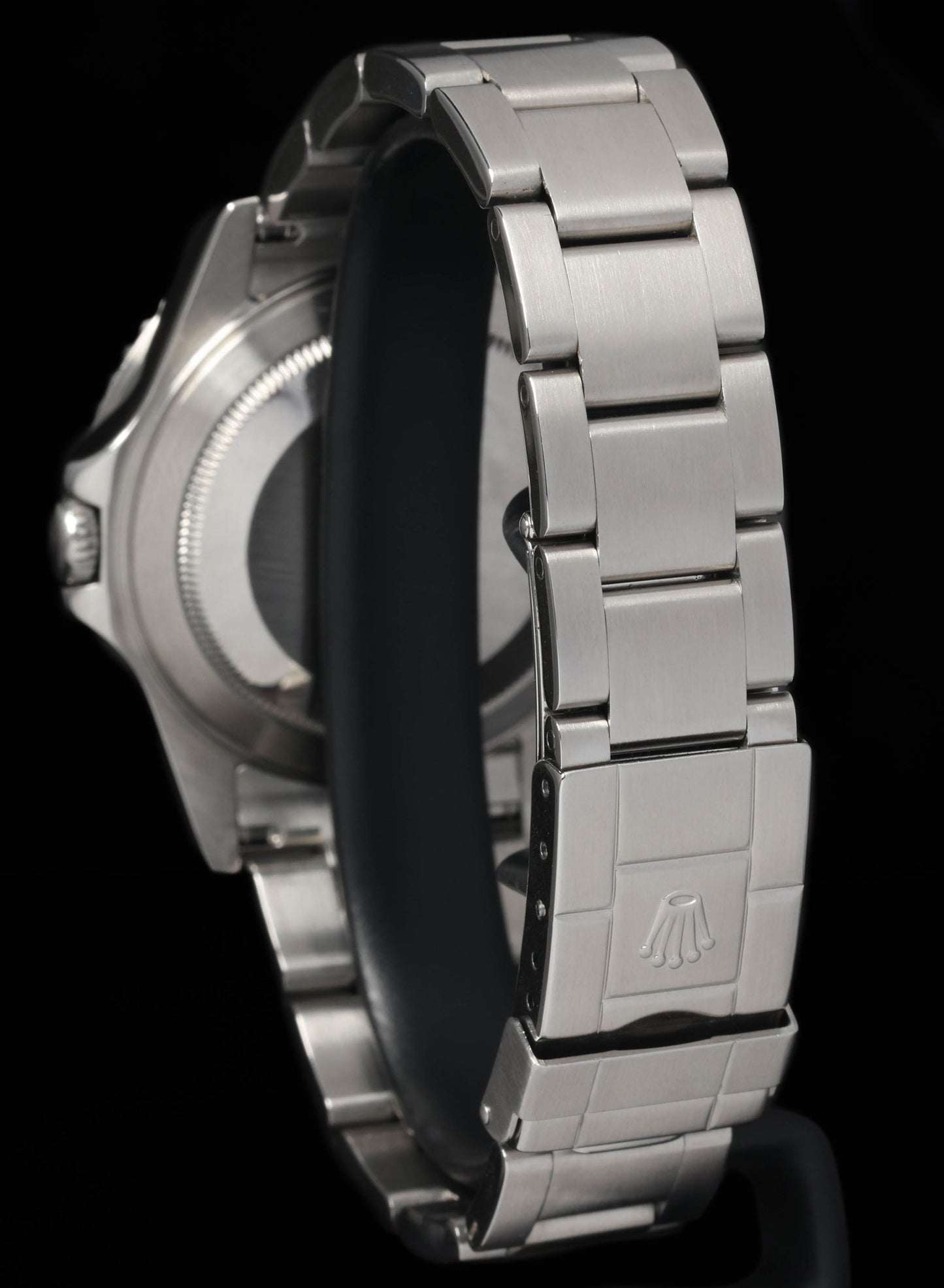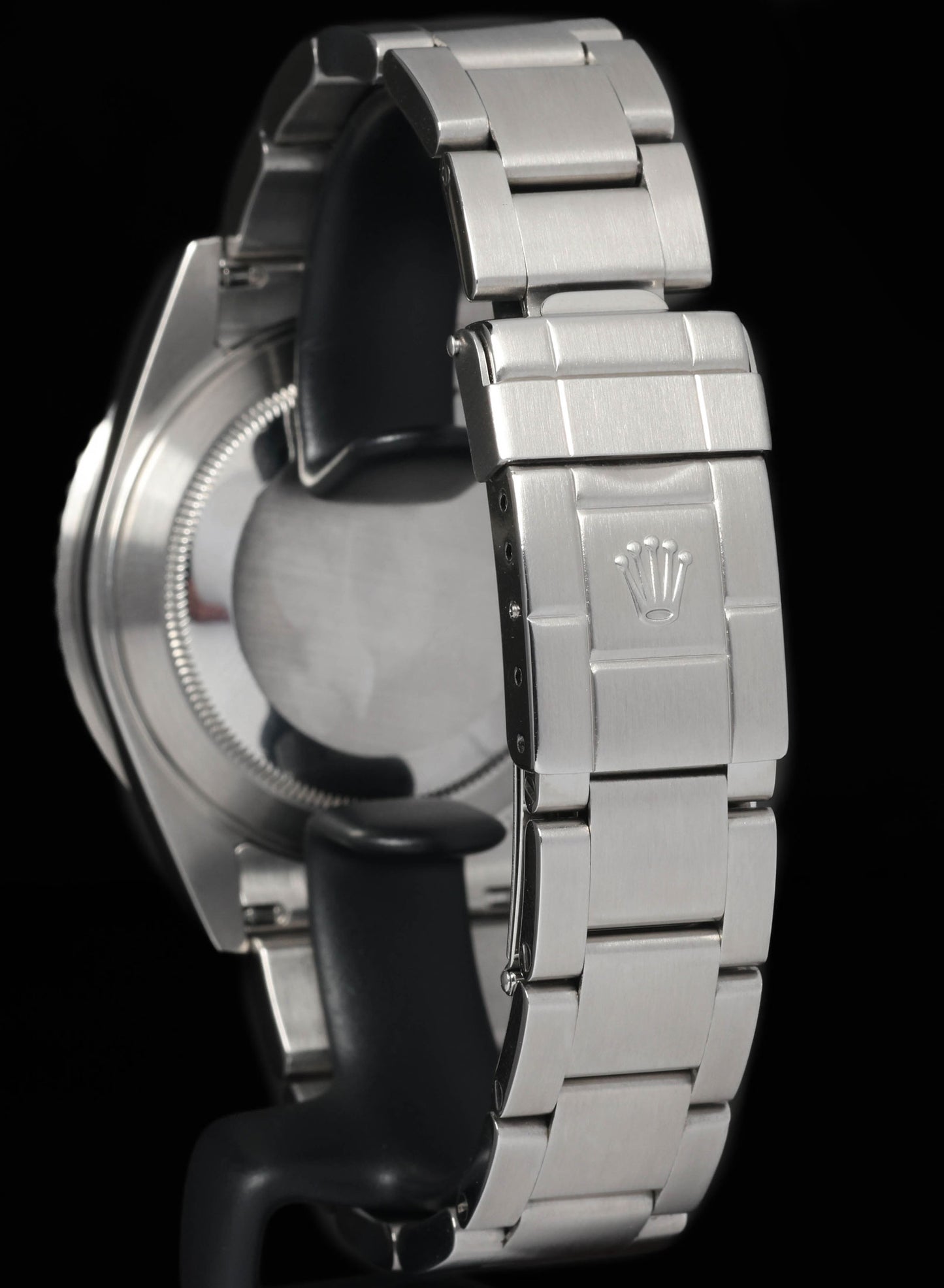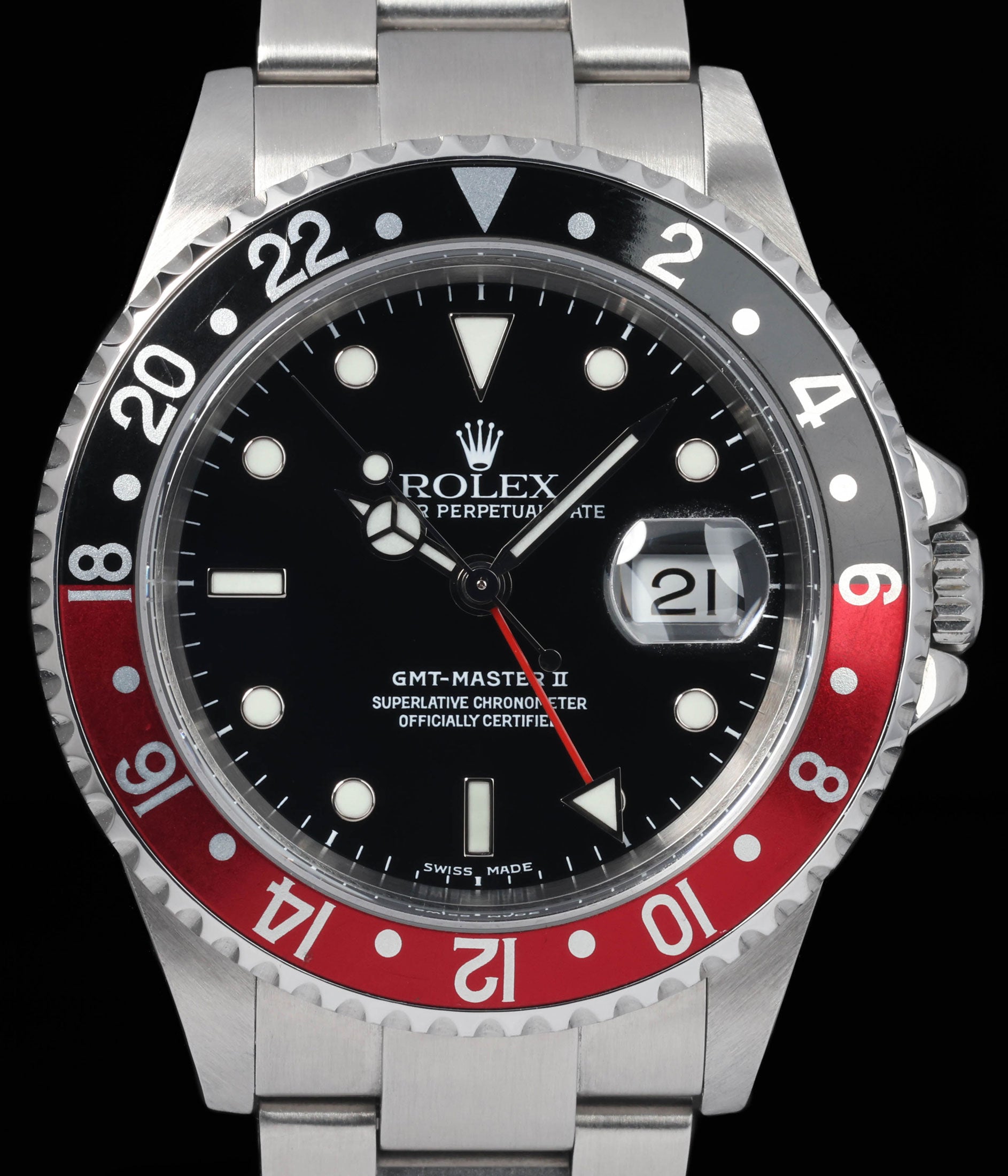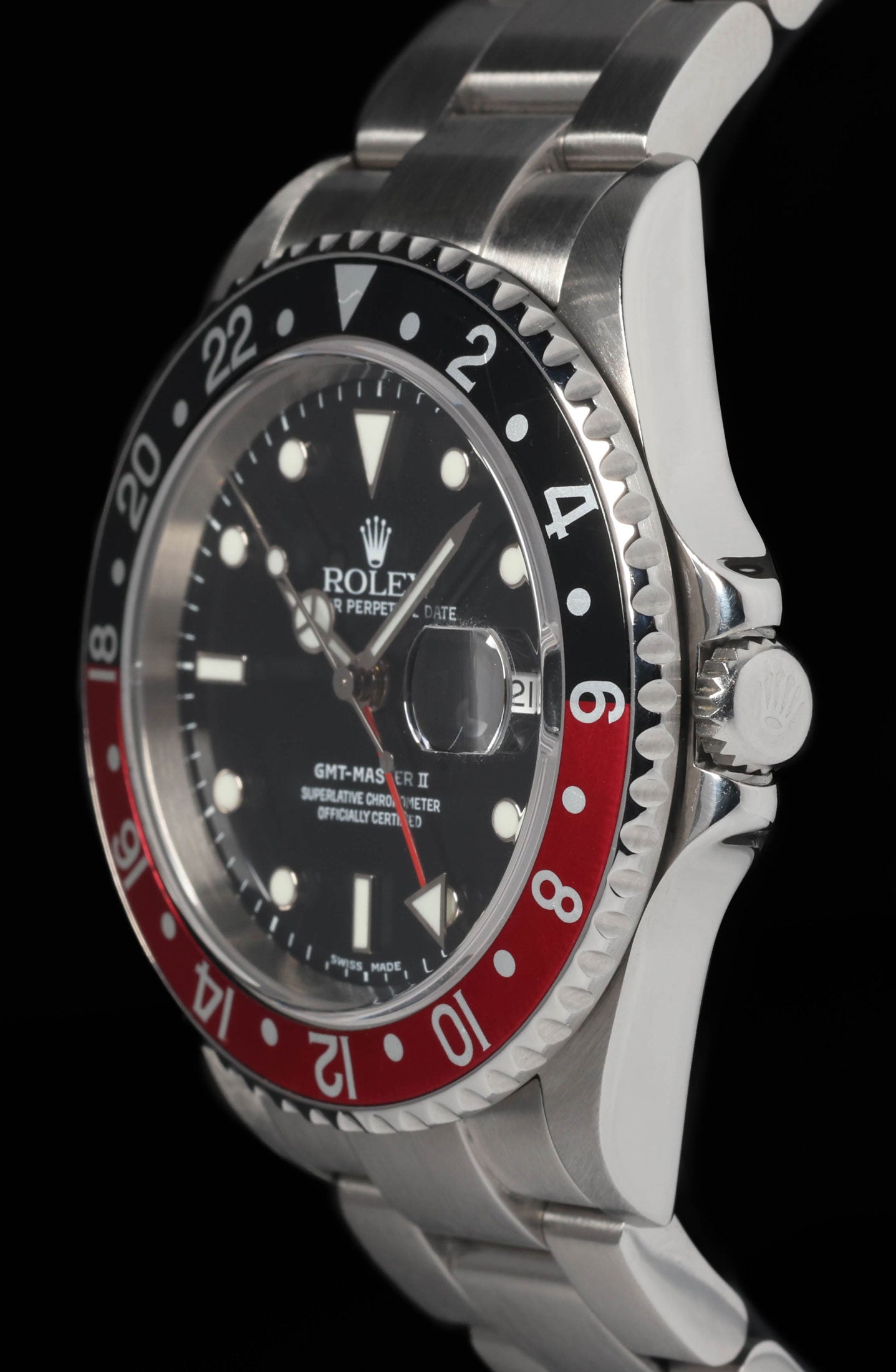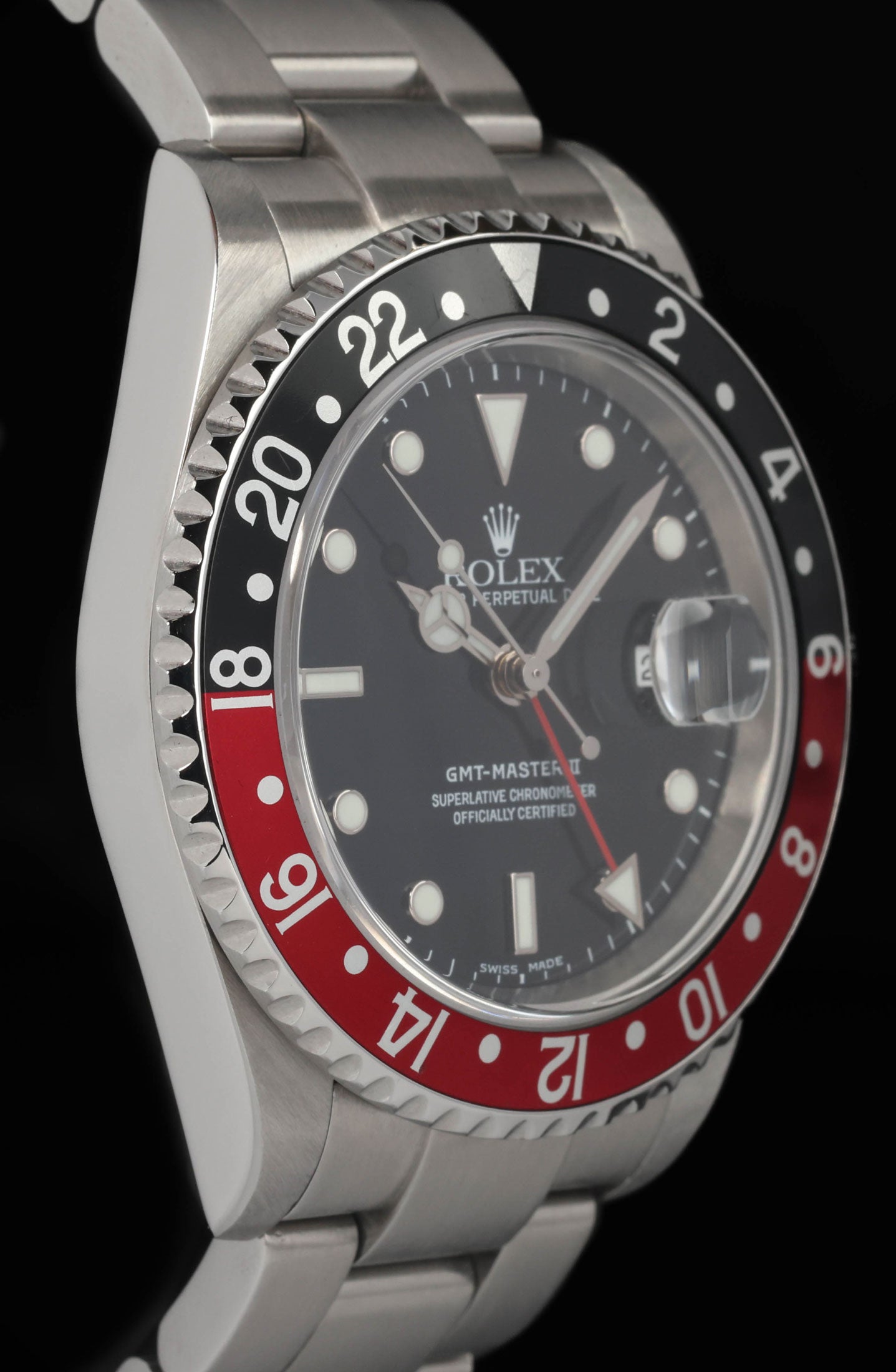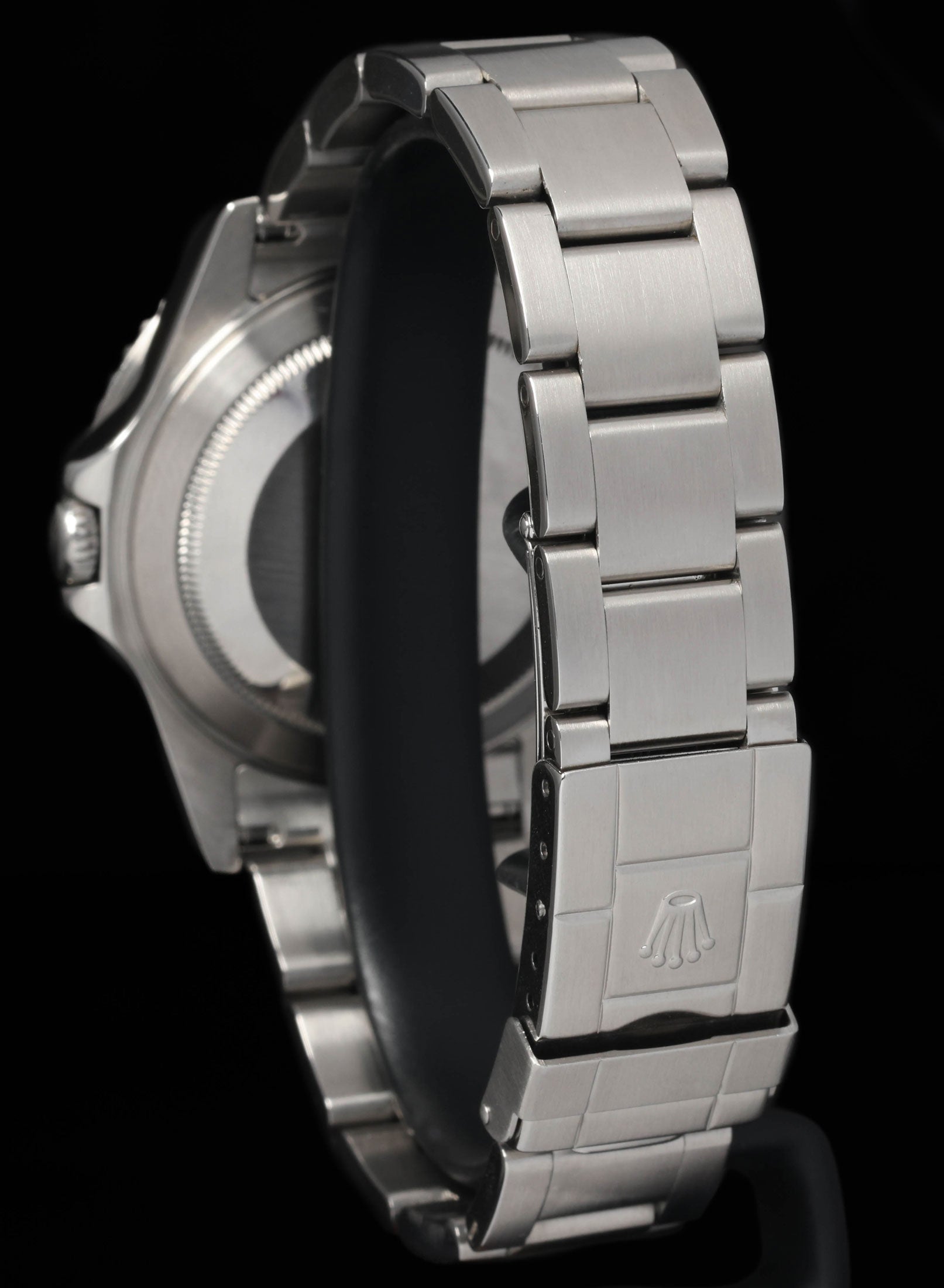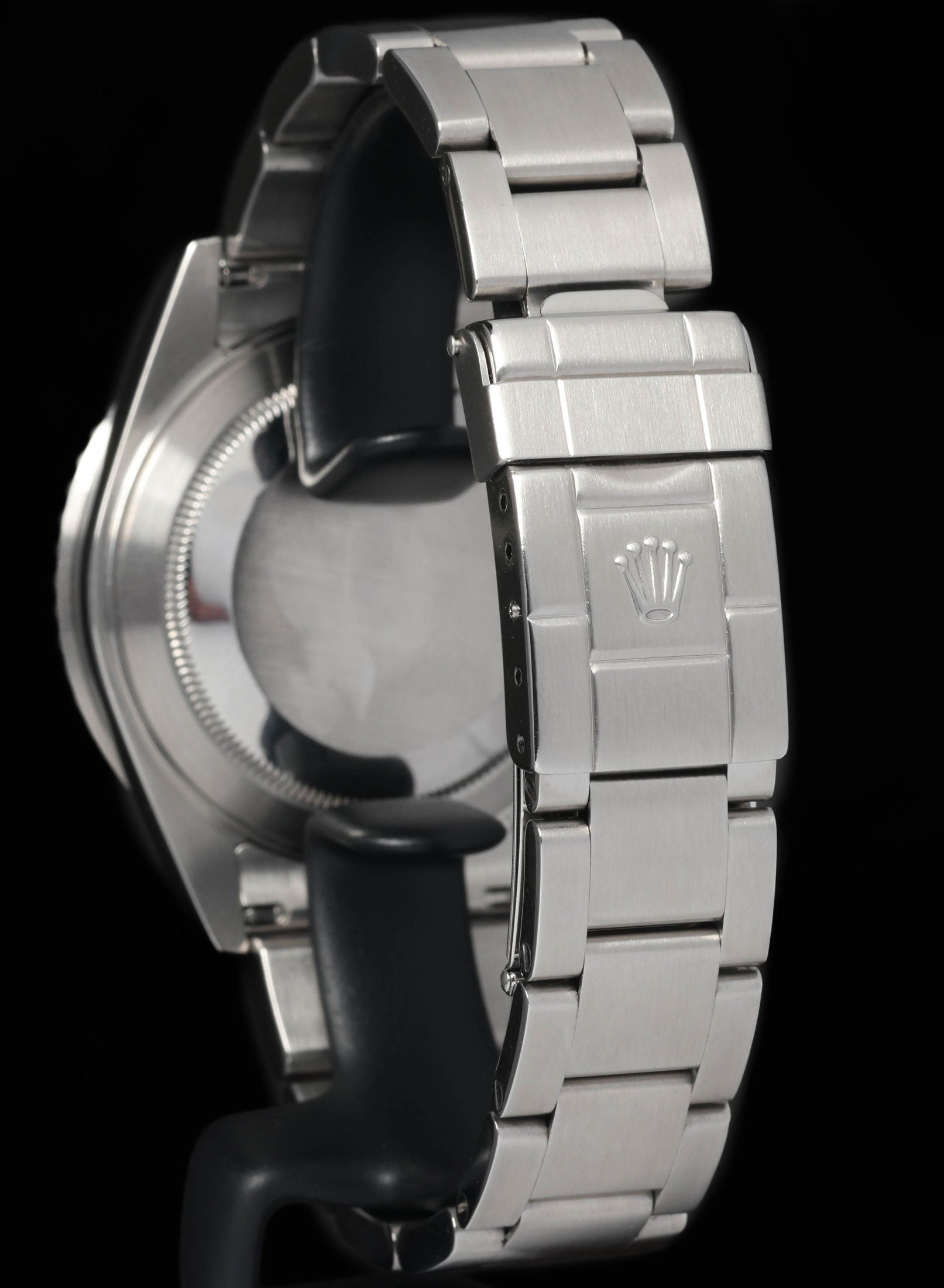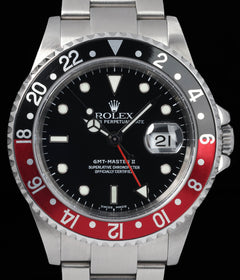Crown Vintage
Rolex GMT Master II 16710 'Coke' 40mm 2004
Rolex GMT Master II 16710 'Coke' 40mm 2004
Couldn't load pickup availability
Rolex GMT Master II 16710 'Coke' 40mm 2004
This Rolex is presented in very good overall condition with minimal signs of wear. The case retains strong lugs with factory brushing still visible, highlighting its well-preserved lines. The Oyster bracelet remains in excellent condition with little to no wear and only minor stretch consistent with age. The dial and hands are flawless, displaying crisp details and an untouched finish. Overall, this is a superbly kept example that reflects careful ownership and originality.
Share
Why we love this watch
Why we love this watch
Rolex GMT-Master II 16710 “Coke”: A Transitional Classic
Produced from 1989 until its discontinuation in 2007, it served as the backbone of the GMT line for nearly two decades and bridged the divide between the vintage references of the 1970s and 1980s and the six-digit ceramic era that followed. Among the three bezel configurations offered—Pepsi, all-black, and Coke—it is the red-and-black “Coke” bezel variant that has carved out a distinctive reputation among enthusiasts. With its bold colour scheme, sleek aluminium insert, and slim case proportions, the Coke 16710 represents both the end of one era and the foundation of another.
The GMT-Master Legacy
The GMT-Master was born in the 1950s as a practical solution to the needs of pilots. Pan Am Airways approached Rolex to develop a wristwatch that would allow their crews to track multiple time zones on long-haul flights. The resulting GMT-Master reference 6542 introduced the iconic rotating 24-hour bezel and fourth hand, instantly distinguishing it from the Submariner and Explorer. Through the 1960s and 1970s, references such as the 1675 cemented the GMT-Master’s reputation as a professional travel watch. By the 1980s, the GMT-Master II was introduced, featuring an independently adjustable hour hand that allowed travellers to jump between time zones without affecting the other functions of the watch. This technical upgrade set the stage for the 16710, a watch that refined the concept and carried it into the modern era.
The 16710 Case and Design
The case of the 16710 retained the familiar 40mm diameter and classic Oyster profile, but it introduced subtle refinements that made it distinctly more modern than its predecessor, the 16760 “Fat Lady.” Unlike the oversized case of the 16760, the 16710 returned to slimmer proportions, making it far more wearable across a variety of wrist sizes. Drilled lugs were phased out in later years, but earlier pieces retained them, providing collectors with the option of easy strap changes. The Coke bezel was its most defining visual feature, splitting the aluminium insert into a red and black semicircle. The red represented daylight hours, while the black marked the night, reinforcing the GMT’s original aviation purpose. Over time, the aluminium bezels of these watches often take on character, with fading, scratches, or ghosting adding individuality. Some Coke bezels develop lighter crimson tones while others age into deeper burgundy shades. Collectors prize these variations, as they ensure that no two watches age in quite the same way.
Dial Variants and Lume
The dial of the 16710 remained consistent in its overall layout throughout its production, with applied white-gold surrounds on the luminous hour markers, Mercedes hands, and the GMT arrow hand in red. However, there were subtle changes across the years. Early examples used tritium lume, indicated by “Swiss-T<25” at six o’clock, before transitioning to Luminova around the late 1990s and then to Super-Luminova in the 2000s. Each luminous material carries its own appeal: tritium with its tendency to age to cream or custard tones, and Super-Luminova for its stability and long-lasting glow. The Coke bezel version often paired particularly well with the red GMT hand, creating a cohesive aesthetic that was slightly more understated than the Pepsi version while retaining a bold identity distinct from the all-black variant.
Movements: Calibres 3185 and 3186
Powering the GMT-Master II 16710 for most of its life was the Rolex calibre 3185. This automatic movement, part of the 3100 series, ran at 28,800 vibrations per hour and offered hacking seconds, quickset date, and an independently adjustable 12-hour hand. The innovation of the jumping hour hand is what made the GMT-Master II superior to its predecessors for frequent travellers, as the local time could be adjusted without disturbing the 24-hour hand or the movement’s accuracy. Late in the production run, Rolex introduced the calibre 3186, which featured a larger balance wheel with Rolex’s proprietary Parachrom hairspring for improved resistance to shocks and magnetism. The transition was subtle and mostly invisible externally, though collectors often distinguish 3186-equipped 16710s by their “wiggle test”—the 24-hour hand on a 3186 tends to move with less play than on the 3185. While the 3186 appeared only in the final years, the 3185 remains a robust and reliable calibre that continues to perform well in real-world use.
The Bracelet and Clasp
The bracelet fitted to the 16710 was the Oyster reference 78790, featuring solid outer links with hollow centre links and stamped end links. Later versions transitioned to solid end links (SEL), giving the watch a more substantial feel. Collectors often debate the merits of hollow versus solid end links: the former retains the lighter, rattlier charm of vintage Rolex bracelets, while the latter feels more modern and secure. The clasp remained stamped and featured Rolex’s signature safety lock system. For collectors today, originality of bracelet, correct reference stamping, and the presence of full links can all influence desirability and value. Many examples from the period were worn hard as daily travel watches, making well-preserved bracelets with minimal stretch harder to source.
Wearing the Coke 16710
On the wrist, the Coke 16710 offers the perfect balance of vintage proportions and modern functionality. At 40mm and relatively slim compared to the later ceramic models, it wears flat and comfortably. The aluminium bezel adds a warmth and character that ceramic lacks, and its vulnerability to scratches and fading is often viewed not as a flaw but as an opportunity for the watch to develop individuality. The dual-tone bezel makes the watch more versatile than its Pepsi counterpart, with the darker red and black combination pairing easily with both casual and formal attire. It is a watch that feels as natural in the office as it does strapped over a pilot’s jacket or paired with travel gear.
The Coke Versus the Pepsi
The natural comparison for the Coke is the Pepsi, the most famous colourway in the GMT-Master lineage. The red-and-blue insert has the strongest ties to Rolex history, being present from the very first reference in the 1950s. Yet the Coke offers something different: a sharper, more contemporary edge that suits those who find the Pepsi’s palette too bright. The black half of the Coke bezel grounds the design, giving it a slightly more understated appearance while the red retains the GMT identity. This duality makes it attractive to collectors who want something distinct but still rooted in the model’s heritage. While the Pepsi often commands higher recognition in mainstream circles, the Coke has built a loyal following that values its unique place in the lineup.
From Aluminium to Cerachrom
The discontinuation of the 16710 marked the end of aluminium bezel inserts in the GMT-Master II line. The successor, reference 116710, introduced the maxi case, ceramic Cerachrom bezel, and an updated calibre. While the 116710 brought technical improvements in scratch resistance and overall durability, it also altered the character of the GMT-Master II. The case became bulkier, the glossy ceramic bezel lost the tendency to age and fade, and the watch stepped more decisively into the luxury space rather than the professional tool category. For many collectors, this shift makes the 16710 more appealing, as it embodies the last generation where the GMT still retained a balance of ruggedness and refinement.
The Coke’s Place in the Lineage
The Coke bezel debuted with the 16760 “Fat Lady” in the mid-1980s and carried through to the 16710. Its discontinuation left a gap in the Rolex lineup that has yet to be filled. For collectors, this gap enhances the Coke’s identity as something both familiar and irreplaceable. It carries the DNA of the earliest GMT-Masters but with modern refinements that make it wearable today without compromise. In many ways, it is the sweet spot of the GMT lineage: vintage charm with sapphire durability, aluminium warmth with modern proportions, and mechanical robustness without the over-engineered aesthetics of later models.
Final Thoughts
The Rolex GMT-Master II 16710 Coke stands as one of the most compelling sports watches of its generation. Its slim case proportions, aluminium red-and-black bezel, reliable calibre, and transitional design language capture a moment in Rolex history that feels increasingly distant. With modern Rolex firmly planted in the world of ceramic bezels and maxi cases, the Coke 16710 represents the last chapter of the aluminium era, combining vintage charm with contemporary durability. Its discontinuation has only enhanced its appeal, ensuring it remains one of the most sought-after GMT-Master II variants.
Case & Bracelet
Case & Bracelet
Case in very good condition with little to no wear visible. Strong lugs with factory brushing still visible. Bracelet in excellent condition with little no wear visible. Some stretch expected with age.
Dial & Hands
Dial & Hands
Dial and hands are flawless.
Warranty & Condition
Warranty & Condition
Crown Vintage Watches provides a minimum 3-month mechanical warranty on pre-owned watches, from the date of purchase.
The warranty covers mechanical defects only.
The warranty does not cover damages such as scratches, finish, crystals, glass, straps (leather, fabric or rubber damage due to wear and tear), damage resulting from wear under conditions exceeding the watch manufacturer’s water resistance limitations, and damage due to physical and or accidental abuse.
Please note, water resistance is neither tested nor guaranteed.
Shipping and insurance costs for warranty returns to us must be covered by the customer. Returns must be shipped via traceable courier. Return shipment must be pre-paid and fully insured. Collect shipping will be refused. In case of loss or damages, the customer is liable.
Our Pledge
At Crown Vintage Watches, we stand by the authenticity of every product we sell. For added peace of mind, customers are welcome to have items independently authenticated at their own expense.
Condition
Due to the nature of vintage timepieces, all watches are sold as is. We will accurately describe the current condition and working order of all watches we sell to the best of our ability.
Shipping & Refund
Shipping & Refund
